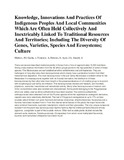| dc.contributor.advisor | | |
| dc.contributor.author | Midiwo, JO | |
| dc.contributor.author | Guchu, s | |
| dc.contributor.author | Yenesew, A | |
| dc.contributor.author | Dereses, S | |
| dc.contributor.author | Ayoo, JA | |
| dc.contributor.author | Aluoch, A | |
| dc.date.accessioned | 2013-05-29T14:39:02Z | |
| dc.date.available | 2013-05-29T14:39:02Z | |
| dc.date.issued | 2002 | |
| dc.identifier.citation | hytochemistry Reviews, 1,311-323 (2002), (201 | en |
| dc.identifier.uri | http://erepository.uonbi.ac.ke:8080/xmlui/handle/123456789/27140 | |
| dc.description.abstract | There are several described medicinal plants in Kenya from a flora of approximately 10,000 members. Strong cross-medical information from the 42 ethnic groups points to the high potential of some of these species. The Myrsinaceae are well established ethno-anthelmintics and anti-bacterials. They are harbingers of long alkyl side chain benzoquinones which clearly have a protective function from their histochemical disposition. The main benzoquinone in the sub-family Myrsinodae is embelin while for the Maesodae it is maesaquinone together with its 5-acetyl derivative; the distribution of these benzoquinones by their alkyl side chain length or the presence/absence of a 6-methyl group is in accord with morphological sub-family de-limitation. The benzoquinones showed anti-feedant, anti-microbial, phytotoxic, acaricidal, insecticidal and nematicidal activity. Many other benzoquinones of medium and minor concentration were also isolated and characterised. Some plants belonging to the Polygonaceae which are widely used as ethno-anthelmintics have been studied. The common anthelmintic anthraquinones were obtained from all five Rumex species while the naphthalenic acetogenin derivative, nepodin was more selectively distributed. The leaf of Polygonum senegalense is up to 17% surface exudate; about thirteen non polar flavonoid derivatives (chalcones, dihydrochalcones, flavanones and a flavone) have been isolated from it. From the internal aerial tissues of this plant, the major flavonoids were common flavonoids, quercetin, kaempferol, luteolin and their glycosides. The only unique compound isolated from this plant was 2prime-glucosyl-6prime-hydroxy-4prime-methoxydihydrochalcone whose aglycone, uvangolatin is part of the exudate mixture. Other leaf exudate plants studied include the stomach-ache medicine, Psiadia punctulata (Compositae) from which novel methylated flavonoids, kaurene and trachyloban diterpenes have been found | en |
| dc.language.iso | en | en |
| dc.subject | Knowledge, innovations and practiceS | en |
| dc.subject | indigenous peoples and local communities | en |
| dc.title | Knowledge, Innovations And Practices Of Indigenous Peoples And Local Communities Which Are Often Held Collectively And Inextricably Linked To Traditional Resources And Territories; Including The Diversity Of Genes, Varieties, Species And Ecosystems; Culture | en |
| dc.type | Article | en |

